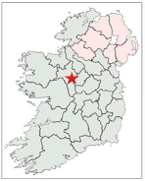
County Roscommon is marked by the red star on the map to the right.
Historic Background
The modern County of Roscommon is part of the province of Connacht. There is significant evidence that this province was occupied far back into prehistory. Examples of this can be found in County Mayo in the Ceide Fields, a field system that dates to about 3500 BCE. In modern County Sligo there are at least three major neolithic cemeteries, Listoghil, Carrowkeel and Carrowmore. And in modern County Roscommon, the Rathcroghan complex, actually Cruachan, has been identified as the traditional capital of the Connachta. The sites in the Rathcroghan complex include Neolithic, Bronze Age and Iron Age sites. The Rathcroghan area was a significant religious site, especially related to burials, and a place(s) of gathering. It is typically listed as one of the six Royal sites of Ancient Ireland.
The name of Connacht derives from the most successful early dynasty in the area, the Connachta. The Connachta were a group of dynasties that all claimed descent from Conn Cetchatharc, “Conn of the Hundred Battles”, a legendary Irish king. (Charles-Edwards p. 36) These dynasties seems to have expanded outward from Cruachain, the traditional capital of Connaught. By 1050 various dynasts of the Connachta controlled Roscommon, Galway, Mayo, Sligo and Leitrim.
According to Ptolemy’s second century map, the area of modern Roscommon was inhabited by the Auteri, who also occupied County Galway. The name Roscommon derives from the Irish Ros, a wooded, gentle height and Coman, the name of the first abbot and bishop of Roscommon, who founded a monastery in what is now the town of Roscommon in 550. (https://www.irishcentral.com/roots/ireland-county-names-mean-translations)
In the 500’s, in the area that is now largely County Roscommon, the Connachta are seen to be expanding to the north, south and west. By about 600, this same area has the tribal name of Ui Briuin as the primary tribe in the area. (http://sites.rootsweb.com/~irlkik/ihm/) The Ui Briuin, along with the Ui Fiachrach, were “sons of Eochu Mugmedon, a fourth century ‘high king’ of Ireland. Eochu’s son Brion was the ancestor of the Ui Briuin, who along with the descendants of Eochu’s son Fiachra Foltnaithech, ancestor of the Ui Fiachrach, were to rule the province of Connacht for seven centuries.” (http://sites.rootsweb.com/~irlkik/ihm/irehstry.htm) From about 406 to about 956, a period of at least 550 years, the Kings of Connacht came from one or another of the families of either the Ui Briuin or the Ui Fiachrach. (https://en.wikipedia.org/wiki/List_of_kings_of_Connacht) There were three main groups of the Ui Briuin, the most significant of which, for the history of County Roscommon, were the Ui Briuin Ai. It is worth noting that another son of Eochu Mugmedon was Niall, known as Niall of the Nine Hostages, the ancestor of the Ui Neill, who dominated the High Kingship of Ireland for about 350 years from about 379 to about 846.
In what is now southern County Roscommon, another tribal dynasty was significant, the Ui Maine or Hy Many. They were centered in eastern County Galway and southern Roscommon. The Ui Maine moved into this area in the fifth century and were “said to be descended from Colla da Crioch (one of the Three Collas). (http://sites.rootsweb.com/~irlkik/ihm/uimaine.htm) The Ui Maine took their name from one of their chieftains, Maine Mor. The Ui Maine were a collection of various septs and tribes that were “inter-connected by actual or synthetic genealogies.” (http://sites.rootsweb.com/~irlkik/ihm/uimaine.htm)
Ecclesiastic History
The situation described above prevailed during the time of the introduction of Christianity into Ireland. It is clear from the list of early Monastic Houses in County Roscommon that St. Patrick made a tour through the area. The following monasteries are attributed to St. Patrick: Ardsenlis, Boyle Abbey, Elphin, Fuerty, Kilmore and Oran. In addition, several monasteries are listed as being founded during the time of St. Patrick. These are: Baslick, Cloonshanville, Drumconnel and Emlagh. Thus, by the early sixth century there were already at least ten monasteries in what is now County Roscommon that are connected in some way to St. Patrick. Another twelve monasteries, founded by persons, other than St. Patrick, in the late fifth century or the sixth century include: Ardcarn, Assylin, Cloonburren, Cloonowen, Cloontuskert, Creeve, Drum, Inchmacnerin, Kilmore, Loughkey, Roscommon and Tibohine. Thus, by the year 700, there were numerous monasteries located in what is now County Roscommon.
The following is a list of early monasteries in County Roscommon. (https://en.wikipedia.org/wiki/List_of_monastic_houses_in_Ireland#County_Roscommon)
Ardcarn Prioryearly site, founded in 6th century
Ardsenlis Monastery (?) early site, nuns, founded 5th century by St. Patrick, possibly in Roscommon
Assylin Monasteryearly site, founded pre 563 (?) by St. Colmcille
Baslick Monasteryearly site, founded in 5th century (?) in Patrick’s time
Boyle Abbeyearly site, founded in 5th century, by St. Patrick (?)
Carn Monasteryearly site, nuns
Cloonard Abbeyabbey and church
Cloonburren Monastery early site, nuns, founded pre 577-8 by Cairech Dergen
Clooncraff Monastery early site, founded pre 752
Cloonowen Monastery early site, founded in 6th century (?)
Cloonshanville Priory early site, founded in 5th century (?) in Patrick’s time
Cloontuskert Priory early site, founded in 6th century by St. Faithlinn
Creeve Monasteryearly site, founded early 6th century by St. Finnian of Clonard
Domnach-mor early site
Drum Monasteryearly site, founded late 5th century (?) by Diradius
Drumconnel Monastery early site, founded 5th century by St. Conal (?) in Patrick’s time
Elphin Monasteryearly site, founded c. 450 by St. Patrick
Elphin Greyfriarsearly site, founded 5th century by St. Patrick
Emlagh Monasteryearly site, founded in 5th century (?) in Patrick’s time
Fuerty Monasteryearly site, founded in 5th century by St. Patrick
Inchmacnerin Abbey early site, founded 6th century by Patrician monks
Kilcanuran Monastery early site
Kilcooley Monastery early site
Kildallog Monastery early site
Kilmore Monastery early site, founded in 5th century by St. Patrick
Kilmore Monastery early site (?) separate from above, founded in 6th century by St. Colmcille
Kilnamanagh Monastery early site, founded in 5th century by St. Patrick
Kilronan Abbeyearly site, 6th century
Kiltrustan Monastery early site
Loughkey Abbeyearly site, founded by 700
Ogulla Monasteryearly site
Oran Monasteryearly site, founded 5th century by St. Patrick
Roscommon Abbey early site, founded 6th century by St. Comman
Templemoyle Abbey possible early site
Tibohine Monastery early site, founded late 6th century by St. Baithen Mac Cuanach
Tisara Nunnery
Three of these monasteries had High Crosses, all or parts of which we have. Each of these is discussed below with historical background on the site and saint as available. The Crosses or cross fragments are pictured and their carving is described. These sites are: Cloonshanville, Emlagh and Ogulla.
Cloonshanville Cross
The Site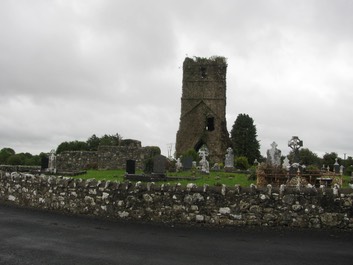
An ancient church was apparently founded at this location by Commituis or Cornedus, a disciple of St. Patrick who was described as bishop of Cluain Seanmhaoil. (Sweetman, p. 83) This would place the foundation of the church or monastery in the 5th or early 6th century. Nothing appears to be know of the history of this early foundation. Later, in 1385, the Dominican priory of the Holy Cross was founded in the area. The ruins of the Cloonshanville Abby are seen to the left.
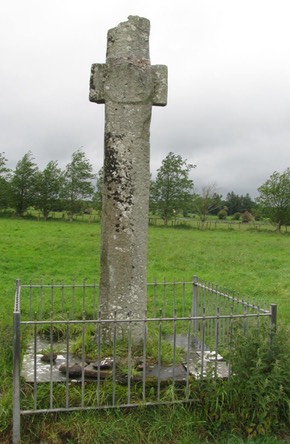
The Cross
Following an archaeological dig, the cross was set in a concrete base. Previously it sat in a shallow depression in the bedrock. The cross is of a rough laminated sandstone. It cross stands 11’6” (3.5m) height and is just over 27” (69cm) inches across the arms. The shaft is 17” (44cm) wide and nearly 8” (20cm) thick. Sweetman suggests a 12th century date for the cross. (Sweetman, p. 84) Harbison notes that the cross may be later as it stands near a 14th century Abbey. He includes it in his listing of Irish High Crosses, giving it the benefit of the doubt. (Harbison, 1992, p. 59) It stands at a distance from the abbey and may have been a termon cross, marking a boundary.
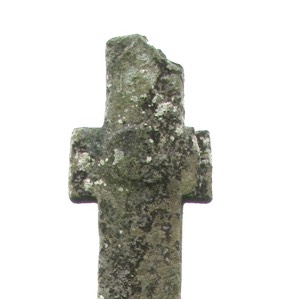
Each face of the cross, see the photo to the right, has a large and crudely made boss at the crossing of the shaft and arms. There seems to be another smaller boss in the center of the head of the cross on the opposite side, see the photo to the left.
No other carving is visible.

Getting There: See the Road Atlas page 24 H 2. Cloonshanville Friary is marked on the Road Atlas as an Abbey. The site is signposted in Frenchpark along the R361 on the northeast side of town. The sign directs you to the Cloonshanville Cemetery. If you go past the Friary and follow the road for about 200m, the cross can be seen in a field to your right. The location is marked by the white circle in the lower left-hand corner of the map.
The map is cropped from the Historic Environment Viewer.
Resources Consulted
Harbison, Peter; "The High Crosses of Ireland: An Iconographical and Photographic Survey", Dr. Rudolf Habelt GMBH, Bonn, 1992. Volume 1: Text, Volume 2: Photographic Survey; Volume 3: Illustrations of Comparative Iconography.
Sweetman, David, “Archaeological Excavation at the Cross of Cloonshanville, Co. Roscommon”, Journal of the Galway Archaeological and Historical Society, Vol. 38 (1981/1982), pp. 83-87.
Emlagh Cross Fragments
The Site
Emlagh shows up in the literature as Imliuch Each, Imliuch Equorum and Imliuch Brocadha. The latter name refers to the saint who tradition says founded the church there. (Connellan, p. 140) In the Tripartite Life, the Annals of the Four Masters, the Martyrology of Aengus, the Martyrology of Gorman and the Martyrology of Tallaght, Emlagh is mislocated from Roscommon to County Mayo. (Connellan, pp. 138-139)
A church was founded there by St. Brocaidh (Brocaid) at the direction of St. Patrick. This must have taken place during the late 5th century. Broach was first ordained as a priest and later consecrated a bishop. While this made Emlagh a bishopric for a time, there is no evidence that it continued as such following St. Brocaidh’s death. (Connellan, pp. 143-144) Emlagh was a monastic foundation during at least part of its history as demonstrated by a passage in the Annals of the Four Masters. “Domhgnasach, abbot of Imleach Each [died].” (Annals of the Four Masters, M757.6)
The Fragments
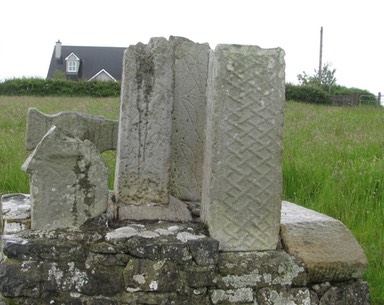
The descriptions that follow are all based on the work of Harbison, 1992, pp. 86-87. The four fragments represent parts of at least three crosses. As seen in the photo to the right, there are three pieces of cross shaft seen from the right to the center of the photo. Another fragment of a shaft, much shorter than the others is in the foreground to the left of the photo and behind it is a cross-head. At least one other possible cross piece, either the top of a shaft or an arm of a head will be pictured below.
Fragment 1:
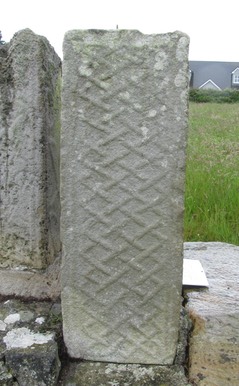
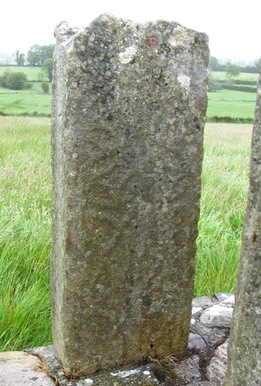
Shaft: This is the second tallest of the fragments. The shaft is 37” (95cm) in height. On one face there is an interlace in relief, as seen in the photo to the left. On the other is an interlace with circular and spiral ornaments above it as seen in the photo to the right. The sides are not decorated.
Cross-Head: The cross-head is not related to any of the shaft fragments. It is about 18” (45cm) in height and 25” (63cm) across the arms. There is no ring. On each face is a boss that is encircled by at least one ring. On the east face there is a smaller boss on one arm and one at the bottom of the head as well. This is pictured to the left below. On the west face, pictured to the right below, there may have been interlace.
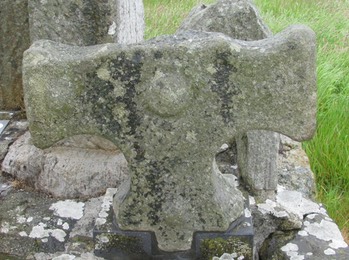
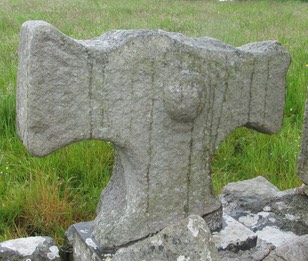
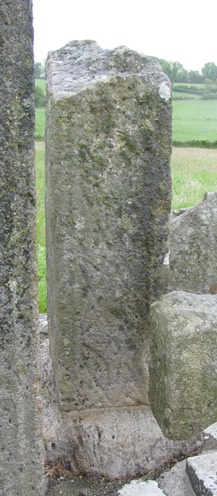
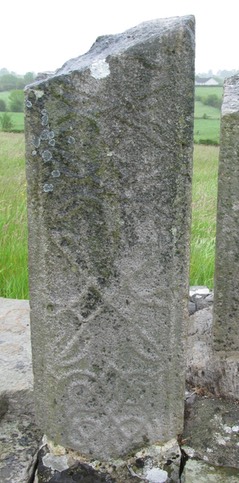
Fragment 2: This is the tallest of the fragments. It is just over 39” (99cm) in height. There is interlace in relief on the east face as seen in the photo to the left, and incised on the west face and both sides as seen in the photo to the right and those of the sides below. Mortise holes on the sides cut into the interlace and are probably the result of a repair.
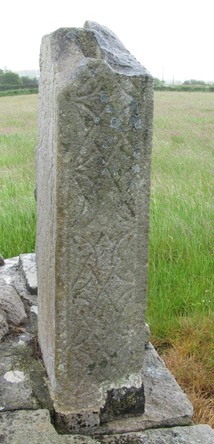

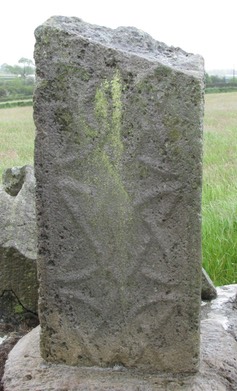
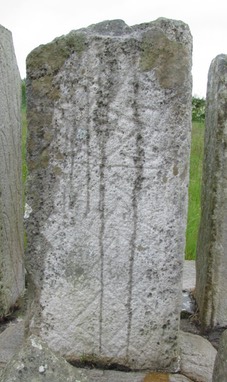
Fragment 3: This shaft fragment may fit with Fragment 2. It stands 33” (84cm) in height. The north face has what appears to be a fret pattern. The south face has interlace and three loop or Stafford knots.

Each side has incised interlace. Side 1 is seen to the right and side 2 to the left. It is the shaft that is partly hidden by the left arm of the cross-head.
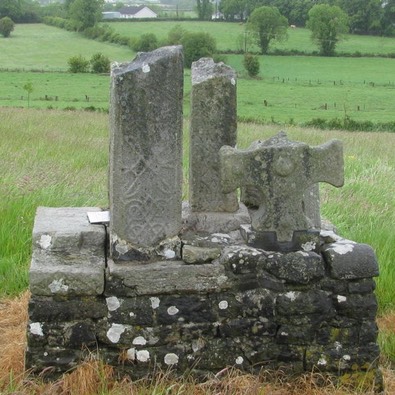
Fragment 4: This is the smallest of the shaft fragments and may be the top of Fragment 1. It stands 18” (46cm) in height. At the top there is a small section of the ring. The east face, seen to the right, has interlace in two panels. The west face, seen to the left, may have had interlace.
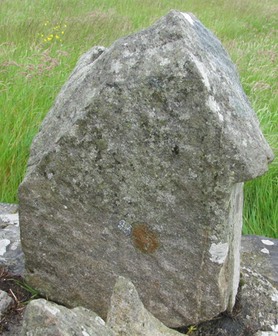
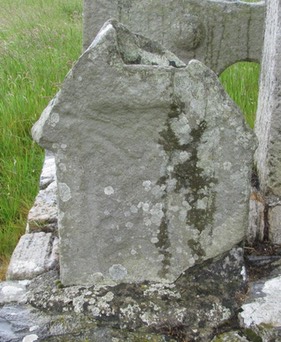
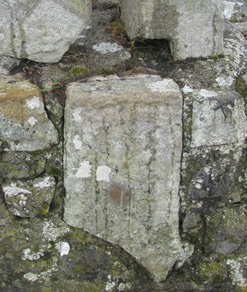
A possible arm fragment? On one side of the plinth and built in is a stone that is of the same material as the cross fragments and looks like it could be an arm of a cross-head, either the upper arm or one of the horizontal arms.
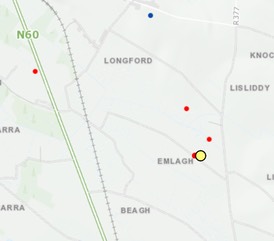
Getting There: See the Road Atlas page 24 GH 4. This site is between Ballymoe and Castlerea east of the N 60.
The turn off is 2km south of Castlerea and 7km north of Ballymoe. The road you want is the L6645 and the sign for this is on the west side of N60, right across from the turn. There is also a brown sign on the east side pointing to the Suck Valley Way (a hiking path). From here to the site it is a single lane road and it is 2-2 1/2km to the site.
You will quickly come to a Y—stay to the right. There will be a handcrafted wooden sign pointing to Ballentubber and the Suck Valley Way. This is your direction.
Next you will come to a railroad crossing. For safety, follow the posted directions carefully.
Follow the lane until the first opportunity to turn left—turn left. Now follow the lane until you come to a white wall in front of a gated driveway and park there. Go into the field across the way using the farm gate. When coming and going please close the gate. The cross pieces are visible mounted together on a plinth in the field. They can be seen clearly from the gate.
The map is cropped from the Historic Environment Viewer.
Resources Consulted
Annals of the Four Masters, http://www.ucc.ie/celt/published/T100005A/index.html
Connellan, M. J., “St. Brocaidh of Imliuch Brocadha”, The Journal of the Galway Archaeological and Historical Society, Vol. 23, No. 3/4, (1949), pp. 138-146.
Harbison, Peter; "The High Crosses of Ireland: An Iconographical and Photographic Survey", Dr. Rudolf Habelt GMBH, Bonn, 1992. Volume 1: Text, Volume 2: Photographic Survey; Volume 3: Illustrations of Comparative Iconography.
Ogulla Cross Head
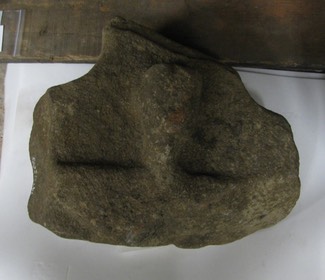
The Site
The Holy Well at Ogulla is reputed to be the Cliabach Well where St. Patrick baptized Eithne and Fidelma, daughters of King Laoghaire of Tara. Near the well there is supposed to be a replica of the Ogulla cross-head. It was not to be found on a visit in 2019. The original is now in the custody of the National Museum. The replica is located near the holy well of Ogulla near a large tree.
The Cross Head
Kelly described the cross and offered photographs in articles for the Journal of the Royal Society of Antiquaries of Ireland in 1993 and 1994. The fragment is the center of a cross-head and is badly damaged. On one face there is a fragment of a Crucifixion scene with the head of Jesus in the center of the head. On the other face there is a boss at the center with a petal-like design surrounding it. (Kelly, 1993, pp. 154, 156)
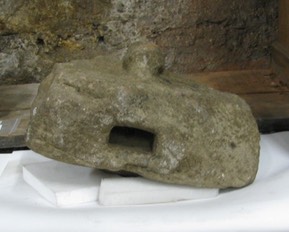
There is a small cross-base that may or may not be related to the cross-head in the southeast corner of the graveyard at Ogulla, across the road from the well. It stands 11” (28cm) in height and is 29” (74cm) by 21” (53cm) at ground level. (Kelly, 1993, p. 154)
There is general agreement that the fragment and base date to the 12th century. The photos were taken by the author on a visit to the National Museum.
Getting There: See Road Atlas p. 25 A 3. The site of the original cross is located just west of Tulsk on a side road off the R367. The original cross fragment is housed in the National Museum in Dublin, but for two years, starting in November 2018, the original is on display in the Rathcroghan Visitor Centre Museum in Tulsk. A copy is said to be located at the site as noted above. This is signposted as the Ogulla Shrine. The copy of the cross-head was not readily visible and those asked knew nothing about it.
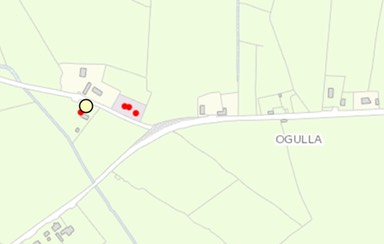
The map is cropped from the Historic Environment Viewer
Sources Consulted
Historic Environment Viewer, http://webgis.archaeology.ie/historicenvironment/. County Roscommon, Cross: High Cross, Ogulla.
Kelly, Dorothy, “Cross at Ogulla, County Roscommon,” The Journal of the royal Society of Antiquaries of Ireland, Vol. 124 (1994), pp. 213-214.
Kelly, Dorothy, “Some Remains of High Crosses in the West of Ireland,” The Journal of the Royal Society of Antiquaries of Ireland, Vol. 123 (1993), pp. 152-163.